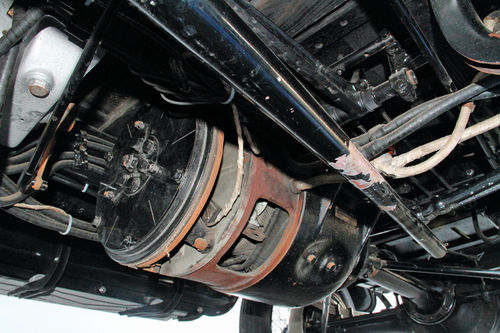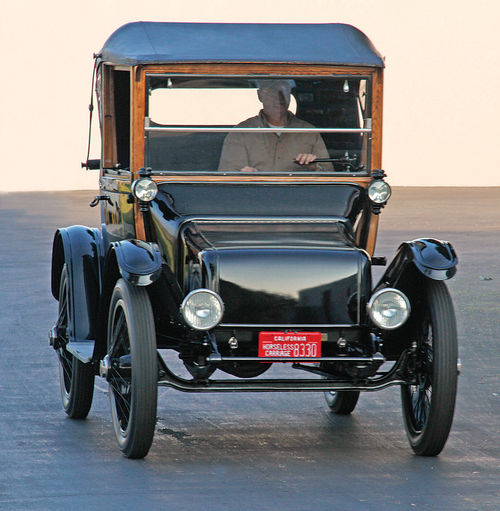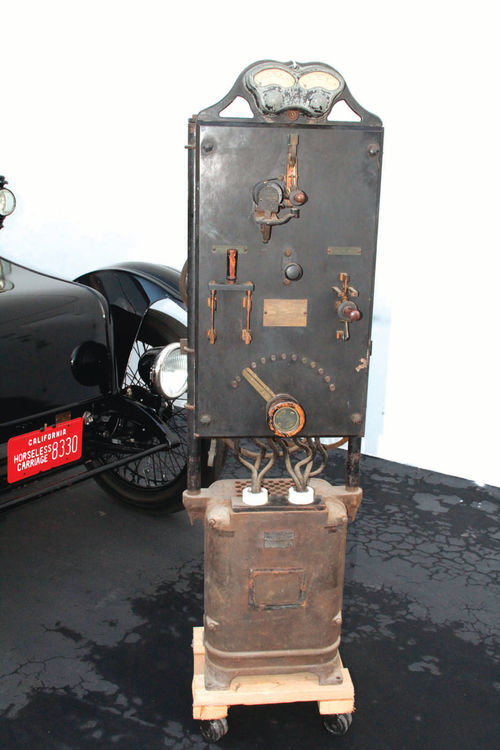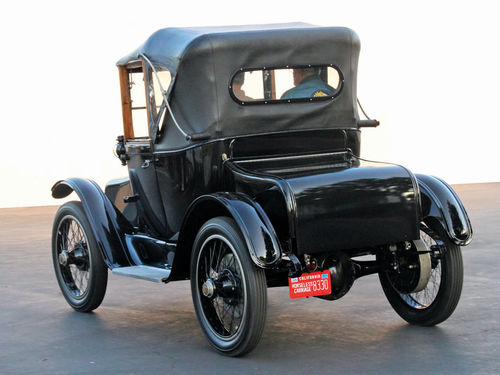1917 DETROIT ELECTRIC 62A Convertible Coupe
Electric Cars Ruled Our Roadways In the Early Years of the 20th Century With Their Quiet, Smooth Performance. Could They Be Starting a Comeback Phase as We Speak?
PICTURE A CITY where most cars are electric, as are the busses and trolleys on the main streets. Pollution is way down from what it was a few years ago, and there are charging stations into which you can drive and park. They are indoor facilities and you can plug in your car while you go shopping or to the theater. Some of these stations are two stories high and can charge over 100 cars at a time. And if you live nearby, you can even store your car there and have it maintained. Could this be what the future has in store for us?
Maybe…but I am actually talking about major U.S. cities a century ago. You see, Eric Lubben’s 1917 Detroit Electric model 62A is but one of many electric automobiles made in the early part of the twentieth century, and the above describes its environment. Baker, Rauch and Lang, Studebaker and literally a hundred others also made the EVs that plied the downtown streets into the teens of the last century. Fact is, in 1900, electric cars decisively outsold gasoline as well as steam-powered cars. The Anderson Electric Co. that built the Detroit Electric was making over 1500 cars a year by 1910, and did very well through the next decade.
The tables didn’t really turn decisively in favor of gasoline-powered cars until 1912 when Cadillac debuted Charles Kettering’s electric starter. With that, people no longer had to deal with a potentially dangerous hand crank on an internal combustion engine and while gasoline-powered cars of the time tended to be smelly and noisy, they also had a much greater driving range than EVs. Electric car sales began dropping at that point, but picked up a bit again when World War I broke out and gasoline became expensive. But by that time Henry Ford’s Model T had come on the scene, and you could purchase one of them for just $600, which was the price of a nickel-iron battery pack for a Detroit Electric car that in 1917 carried a vehicle MSRP of $2300.
Step Into My Mobile Parlor
Now that you have a picture of what things were like when our 1917 Detroit Electric convertible coupe cruised the boulevards, we’ll climb in and take a little tour back in time. I open the carriage-like door and step up and position myself on a plush blue velour loveseat. It feels like I am in a Victorian parlor. Facing me on the passenger side is another single seat done in the same luxurious diamond tuck pattern. The car’s interior smells faintly of powder and perfume…or maybe that’s just my imagination. The Detroit Electric is also quite tall in order to allow ladies to wear their fancy, feathered Edwardian hats and gentlemen their top hats. (I worn neither, opting instead for a ball cap that cleared the ceiling quite easily.)
One thing for sure is that the car does not smell of the gasoline, oil, hot water and cigar smoke that permeated most closed cars made around the turn of the last century. And there is no smell of horse manure either, which was the pollution I was talking about earlier, because electric cars and trams were quickly replacing horses in the cities.



Well-off ladies, who were not inclined to deal with hand cranks or the other drawbacks of contemporary gasoline-powered cars, drove electrics, and much of Detroit Electric’s advertising was designed to reach them. One of the company’s ads stated: “For the bride to be, or the bride of many Junes ago, a Detroit Electric.”
Um…Where’s the Steering wheel and Accelerator
Our 1917 Model 62A is a convertible, unlike most of the electrics of the day. Putting the manually operated top down is too much of an ordeal for our test drive, but I can imagine what it would be like in spring, smelling the flowers as we amble along in silence. Our Model 62 also has 34 x 41 ⁄2-inch Houk, single-nut wire wheels as an extra-cost option, making it rather sporty looking and lightening the car a bit compared to the usual wooden-wheeled vehicles of the time.
I am in the driver’s seat on the left, and I turn a little key to unlock the tiller and speed control levers and drop them down from their folded-away vertical position on my left side to just about a foot above my waist and a foot in front of me. Then I push the little button at the end of the tiller and an electric horn beeps and makes me jump.
What I thought might be the starter turned out to be the horn. Electric cars don’t need starters because when they are stopped they are not running, and when given a little throttle, they are. They’re that simple. At that point Luebben says “step down on both brake pedals (which are next to each other) and push the controller to the first click. Now let up on the brake.” We ease into motion and start oozing along. “Now push the controller forward again.” I do so, and we pick up speed to about eight miles per hour.
All of this happens smoothly and noiselessly without the use of a clutch. There is no exhaust note. Just silence. All you hear is a subtle little creaking of the nearly 100-year-old chassis when you turn a corner. The motor drives through a torque tube to a rear axle and differential, so there is no clanking chain sound typical of a lot of early cars.
The Ride May Be Relatively Slow… But It’s Smooth and Responsive
Tiller steering is easy, instant and one-to-one. In fact, at speed you could probably flip the car on its side if you suddenly pushed the tiller all the way forward. Bumps are inferred rather than felt because of the car’s 3500-pound weight, with its oak framework and its 16 modern replacement batteries. The weight of the batteries, motor and driveline are low in the chassis, so handling is actually good for the time.
I push the throttle lever forward into the next two speeds and performance is almost sprightly. And then I throw caution to the winds and shove the lever full forward, which puts the machine to top speed, which, all in, exceeds the residential speed limit. There are no gears and there is no transmission. There’s no foot throttle either, because speed is controlled by a complex mechanism under the floor.
At rest the battery system is wired at 96 volts. In first speed the front and rear battery packs are wired in parallel at 48 volts through a limit resistor to diminish the current and soften the start. For second speed the limit resistor is shorted to provide the full 48 volts to the motor. For third speed the front and rear packs are wired in series for 96 volts through the limit resistor again. In fourth speed the limit resistor is shorted for 96 volts to the motor. And in fifth, a shunt resistor is switched across the field windings to cause the motor to over-speed for cruising.
Not Bad for Two-Wheel Mechanical Brakes
I lower my side window by pulling up gently on its broad, upholstered strap and then letting it down. This sort of apparatus is common to railway coaches of the era. Seating is comfortable, but a little upright for a slouch like me. Visibility is outstanding, and headroom and legroom are copious. Braking is better than you would expect from a car with two-wheel mechanical brakes, because you also use the magnetic resistance of the electric motor to slow the car. To do so you pull the speed lever all the way toward you and step on the brakes.
Electrics Have Been Around For a Long Time… and Were Quite Popular In Their Day
There are some remarkable facts about early electric cars that aren’t common knowledge. For example, did you know that electric cars predated internal combustion-powered cars by quite a few years? The first electric car powered by batteries was built in 1837 by a chemist named Robert Davidson of Aberdeen, Scotland. And then English inventor Thomas Parker built the world’s first production electric car in London in 1884, using high-capacity rechargeable batteries of his own design.
The first American electric car was built in 1890 by William Morrison of Des Moines, Iowa. It was a six-passenger wagon capable of reaching a speed of 14 miles per hour. That Doesn’t sound like much, but a horse going at a trot can only do about four miles an hour. So 14 mph must have seemed positively peppy. And in 1898 Ferdinand Porsche designed his first car, which was electric. He set a speed record of 62 miles per hour in a second electric car too, which was absolutely flying. (See the April issue for more about the Porsche electrics.)



Famous folks who owned Detroit Electrics included Thomas Edison (no big surprise there), Mamie Eisenhower and John D. Rockefeller, Jr. who had a pair of roadsters. Clara Ford, the wife of Henry Ford, drove Detroit Electrics from 1908 on when Henry bought her a Model C coupe that she used through the late teens. Also, the wives of the owners of many other automobile companies, including Stutz, Packard, Dodge, Studebaker, Cadillac and E-M-F drove Detroit Electrics. (As noted earlier, many women preferred an electric car because you didn’t have to crank-start them, they were relatively easy to handle and they were quiet and odor-free.)
A Brief, But Memorable Run
In 1907 the Anderson Carriage Co. in Detroit — a well-respected manufacturer of horse-drawn carriages — ventured into the production of a vehicle they called the Detroit Electric. Their first cars were equipped with rechargeable lead acid batteries, but nickel-iron batteries were also offered as an extra-cost option from 1911 to 1916. The nickel-iron batteries were so versatile that Jay Leno uses the original ones that came with his Baker Electric when it was first sold in 1909. When the batteries get tired, he just washes them out and replenishes their electrolytes.
But the hay day of the electric automobile was relatively short. After Ransom E. Olds and Henry Ford came out with inexpensive, mass-produced internal combustion-powered cars in the first decade of the 20th century, people began to buy them in greater numbers because they were inexpensive, had a greater range, and could be used in areas of the U.S. that were not yet electrified. And that amounted to most of the country.
Then when the electric self-starter was introduced for gasoline-powered cars in 1912, electric car sales went into a steep decline. As noted above, they did enjoy a temporary resurgence during World War I (when our Detroit Electric was built in 1917) due to the war-driven increased price of gasoline, but that was a short-lived turnaround.
By the ’30s, The Detroit Electric Car Co. only built cars as orders came in, with their final car being built in 1939. The company officially closed its doors in 1942.
They’re Back…Sort Of
Electric vehicles have never completely gone away though. True, they had been relegated to service roles such as golf carts and forklifts until recently, but they are now experiencing a resurgence, even if they still account for a very small portion of the new-car market. (Some predictions say that combined sales of hybrid and plug-in electric cars will account for 5 percent of the U.S. market by 2017.)
Problem is, the shortcomings electric vehicles had 100 years ago are the same ones they have today.
Range is the major one. Truth is, electric cars today, as in the past, had at most about a 200-mile range, although 60 miles was more realistic when driven at normal speeds. A 1911 Detroit Electric went over 200 miles on a single charge but the driver did it by keeping his speed down to a genteel 13 miles per hour. And things have not gotten that much better in the last hundred years. A new Tesla, driven at 55 miles per hour, can supposedly do about 300 miles on a charge. But the Tesla with real-world driving can only do about 225 miles on a charge, and no other electric comes close to that. (Furthermore, the MSRP on a Tesla starts at about $70,000 and can go into the six-figure range.)
The second problem with electric cars that remains to be solved is the time it takes to recharge one. A full recharge on a typical electric car today takes eight hours…not much different than it was 100 years ago. The Tesla, a rather expensive luxury car as noted, can be recharged in five hours, but then a gasoline-powered car can be refueled in five minutes. At the turn of the 20th century switchable battery packs were tried by one manufacturer to help the charge-time situation, but the approach turned out not to be commercially viable.
The third major problem to be overcome is the lack of infrastructure for electric cars. Until motels offer charging stations at their facilities, touring will be difficult. One hundred years ago if you left the city, you were out of luck and out of juice, and it is not much different today. Yes, the country is electrified now, but even today few charging stations exist. All that said, I can think of no more idyllic way to get from A to B than in The third major problem to be overcome is the lack of infrastructure for electric cars. Until motels offer charging stations at their facilities, touring will be difficult. One hundred years ago if you left the city, you were out of luck and out of juice, and it is not much different today. Yes, the country is electrified now, but even today few charging stations exist. All that said, I can think of no more idyllic way to get from A to B than in
They Can Be Quick
Speed has never been a problem. In fact, electric cars are surprisingly fast. Granted our Detroit Electric only did about 28 miles per hour in the day, but that was pretty snappy when you consider that there was no place to go any faster with any guarantee of safety in 1917. Paved roads stopped at the edge of town, and the Interstate highway system was still decades in the future.
Tesla says its cars will do 0 to 60 mph in 4.2 seconds and reach a top end of 130 mph. Ten years ago I drove a General Motors EV1 and it got up to 80 mph on the freeway in seconds, with no shifting. But leaving the EV1 in the weeds, Eric Luebben — owner of our feature car — set an electric car land speed record in October 1997 of 215 miles per hour in a one-off special at Bonneville…and his record only held for a few hours. More recently, Ohio State University built a car they called the Buckeye Bullet 2.5 that did 307 mph on the Salt Flats.
Maybe I Should Get One
Now here we are today rolling around Southern California in an electric car made 100 years ago that does 35 miles per hour as presently equipped. People driving by don’t know what to make of us. The car looks like a tall black phone booth on wheels. Driving it is like driving an extension of your own body; it’s that easy and intuitive. The only thing to which I can compare it is riding in a hot air balloon…quiet, smooth and enjoyable.
Eric says his wife Irene loves the car and enjoys driving it, but she hates his vintage Jaguar. Jay Leno says his wife Mavis’ favorite of his many classic and antique cars is his 1909 Baker Electric. Now I understand why. I never considered restoring a vintage electric, but I may give it some serious thought. But then…maybe not. My wife would probably commandeer it and I would never get to use it anyway.

















